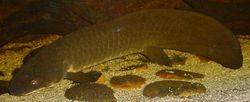Lungfishes
Fossil range: Early
Devonian - Recent |

Queensland Lungfish
|
|
Scientific classification |
| Kingdom: |
Animalia
|
| Phylum: |
Chordata
|
| Subphylum: |
Vertebrata
|
| Class: |
Sarcopterygii
|
| Subclass: |
Dipnoi
Müller, 1844 |
|
| Orders |
|
See text. |
Lungfishes are
sarcopterygian
fish belonging to the order Dipnoi. Lungfish are
best-known for retaining characteristics primitive within
the
Osteichthyes, including the ability to breathe air, and
structures primitive within
Sarcopterygii, including the presence of lobed fins with
a well-developed internal skeleton. Today, they live only in
Africa, South America, and Australia. While vicariance would
suggest this represents an ancient distribution limited to
the Mesozoic supercontinent Gondwana, the fossil record
suggests that advanced lungfish had a cosmopolitan
freshwater distribution and that the current distribution of
modern lungfish species reflects extinction of many lineages
following the breakup of both Pangea and subsequently
Gondwana and Laurasia.
Anatomy
All lungfish demonstrate an uninterrupted cartilaginous
notochord and an extensively developed palatal dentition.
Basal lungfish groups may retain marginal teeth and an
ossified braincase, but derived lungfish taxa, including all
modern species, show a significant reduction in marginal
bones and a cartilaginous braincase. The bones of the skull
roof in primitive lungfish are covered in a mineralized
tissue called cosmine, but in post-devonian lungfishes, the
skull roof is subdermal and the cosmine covering is lost.
All modern lungfish show significant reductions and fusions
of the bones of the skull roof, and the specific bones of
the skull roof show no homology to the skull roof bones of
actinopterygiians or
tetrapods.
The dentition of lungfish is conspicuously different from
that of any other vertebrate group. Odontodes on the palate
and lower jaws develop in a series of rows to form a
fan-shaped occlusion surface. These odontodes then wear to
form a uniform crushing surface. In several groups,
including the modern lepidosireniformes, these ridges have been modified to
form occluding blades.
The modern lungfishes have a number of larval features,
which suggest paedomorphosis. They also demonstrate the
largest genome among the vertebrates.
Modern lungfish all have an elongate body with fleshy
paired pectoral and pelvic fins and a single unpaired caudal fin replacing the
dorsal, caudal, and anal fin of most fishes.
Behavior
African and South American lungfish are capable of
surviving seasonal desiccation of habitats by burrowing into
mud and estivating throughout the dry season. Changes in
physiology allow the lungfish to slow its metabolism to
greater than 1/60th of the normal metabolic rate, and
protein waste is converted from ammonia to less-toxic urea
(normally, lungfish excrete nitrogenous waste as ammonia
directly into the water). Burrowing is seen in at least one
group of fossil lungfish, the Gnathorhizidae. It has been
proposed both that burrowing is plesiomorphic for lungfish
as well as that gnathorhizids are directly ancestral to
modern Lepidosireniformes, but it is possible that the
similarity is simply due to convergent evolution or parallel
evolution.
Taxonomy
Taxonomy of lungfishes can be viewed in terms of
taxonomic position of lungfishes within
Osteichthyes and taxonomic relationships within
lungfishes.
The former is well-resolved. In a
cladogram of osteichthyan relationships, lungfishes clade
closest with Powichthyes, and then with the Porolepiformes.
Together, these taxa form the Dipnomorpha. The dipnomorpha
form a sister group to the tetrapodomorpha. Together, these
are known as the Rhipidistia, and form a sister group to the
coelacanths.
The latter is significantly more difficult to resolve.
While Devonian lungfish retain enough ossification of the
endocranium to determine relationships, post-Devonian
lungfish are represented entirely by skull roofs and teeth,
as the rest of the skull is cartilaginous. Additionally,
many of the taxa that have been identified may not be
monophyletic. Current phylogenetic studies support the
following relationships of major lungfish taxa:
Subclass DIPNOI
,--†Family Diabolichthyidae
| ,--†Family Uranolophidae
| | __,--†Family Speonesydrionidae
'-|-| '--†Family Dipnorhynchidae
| ,--†Family Stomiahykidae
'---| ___ ,--†Family Chirodipteridae
| '-|--†Family Holodontidae
|------†Family Dipteridae
| __,--†Family [[Fleurantiidae]
'-| '--†Family Rhynchodipteridae
'--†Family Phaneropleuridae
| ,--†Family Ctenodontidae
'-| ,--†Family Sagenodontidae
'-|--†Family Gnathorhizidae
'--Order Ceratodontiformes
|--†Family Asiatoceratodontidae
|--†Family Ptychoceratodontidae
|--Family Ceratodontidae
| '--†Genus Ceratodus
| '--†Genus Metaceratodus
'--Family Neoceratodontidae
| '--†Genus Mioceratodus
| '--Genus Neoceratodus - Queensland Lungfish
'--Order Lepidosireniformes
'--Family Lepidosirenidae - South American lungfish
'--Family Protopteridae - African Lungfish
External links
References
Ahlberg, PE, Smith, MM, and Johanson, Z, (2006).
Developmental plasticity and disparity in early dipnoan
(lungfish) dentitions. Evolution and Development
8(4):331-349.
Schultze, HP, and Chorn, J., (1997). The Permo-Carboniferous
genus Sagenodus and the beginning of modern lungfish.
Contributions to Zoology 61(7):9-70.




